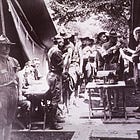On May 31, 2024, I published an essay titled, “History Didn’t Start at Title IX.” In the essay, I challenged the common assumption that women were historically excluded from early research about physical exercise. I explained that a reasonable degree of female participation can be expected in early physical exercise research because much early research on exercise would have been conducted in the fields of physical therapy and physical education. Those two fields pre-dated exercise science, had their own journals, and had large representations of female professors and students.
In the essay, I included photographs from papers published in these journals that showed girls and women participating in this early research. Thus, the essay provided some initial evidence that girls and women were participants in early research studies that pertained to physical exercise. More recently, I made this analysis more formal, and I expanded upon it. The results were recently published in the journal Advances in Physiology Education in a paper titled “Bibliometric guides to early physical exercise, education, and rehabilitation research on girls and women.
Here, my purpose is to briefly explain the methods and results of this new research and reiterate why the findings are important.
My paper had two aims. The first aim was to create a bibliometric list of papers that included photographs of girls and women participating in physical exercise, education, and rehabilitation research prior to 1980. The second aim was to create a bibliometric list of papers that included data or commentary on the menstrual cycle within physical exercise, education, and rehabilitation contexts.
To identify photographs of female participants, I searched the entire archives of three of the most important journals in exercise research history: Research Quarterly (from 1930 to 1979), Journal of Applied Physiology (from 1948 to 1979), and Medicine and Science in Sports (from 1969 to 1979). I then searched my own personal digital archives, which included papers published in other journals. These other journals were not searched entirely because their full archives were not accessible to me.
The search for papers about the menstrual cycle and exercise was more lenient. These papers were noted and filed during the search for photographs and while conducting research for other historical projects.
Both of these historical analyses are to be considered exploratory because not all journal archives were fully searched. Thus, more historical photographs and more data and commentary on the menstrual cycle and physical exercise exist beyond what I published in the two bibliometric lists.
The first bibliometric list consists of 95 papers, published between 1907 and 1979, that included 306 photographs of girls and women participating in physical exercise research. These photographs depicted girls and women performing various tests, and descriptions of the photographs are provided in the paper. The girls and women were most commonly photographed performing or undergoing tests of muscle strength, motor skill learning, body composition, or posture. Example photographs can be seen in my previous post. A sample of the first 15 papers on the list is shown below.
This list parallels the bibliometric list that I published in the Journal of Men’s Health regarding papers published before 1980 that included photographs of male research participants.
The second bibliometric list consists of 77 papers, published between 1876 and 1979, that included data or commentary on the menstrual cycle or menstrual symptoms within physical exercise, education, and rehabilitation contexts. Of the 77 papers, 22 papers were “either reviews or commentaries about the menstrual cycle, consensus statements about women and exercise that included a comment or section about the menstrual cycle, or original papers or review papers that included brief ancillary comments about the menstrual cycle.” The other 55 papers were original research with new data related to the menstrual cycle. This included the following:
1) menstrual symptoms in high school and university students as identified in physical examinations conducted as part of physical education class;
2) menstrual symptoms in athletes and nonathletes as identified by questionnaires;
3) relationships of menstrual symptoms and abdominal strength and other aspects of physical
fitness as measured by laboratory techniques;
4) the impact of oral contraceptives on physical activity and physiological responses to exercise as measured via ecological or laboratory tests.
A sample of the first 17 papers on this list is shown below.
The two bibliometric lists further disprove claims that women were historically excluded from research and that early researchers were not interested in women’s health. Contemporary researchers who conduct audits of female representation typically do not examine journals that are historically linked to exercise science and published in the early- and mid-1900s. Consequently, the exact percentages of male and female participants in early research on exercise, health, and medicine is not known. Moreover, when papers published before 1980 are omitted from audits, and thus studies in the two bibliometric lists are not identified, this gives readers an impression that early researchers, many of whom were femalephysical educators and therapists, were disinterested in women’s health, including in the menstrual cycle. But this assumed disinterest is a myth.
My latest pre-printed paper further challenges this myth. In the paper, I tallied the number of male and female participants in all studies published in Research Quarterly between 1930 and 1979. The results revealed that after two large military studies of male participants were excluded as outliers, girls and women comprised 40% of all research participants. That is hardly evidence “widespread exclusion” of women from research trials, disinterest in women’s health, or bias or discrimination against women.
My hope is that these new historical analyses will be used by educators to teach themselves and their students about the history of male and female participation in early exercise and exercise-related research. This history is nuanced and is not explained by false blanket assertions such as women being historically excluded from research, or that early researchers were disinterested in women’s health issues. In fact, one interesting aspect of this nuanced history, which my latest pre-printed paper confirms, is that participant sex correlates with researcher sex. Thus, one reason why studies within some areas might show greater male than female participation is because of greater male than female researcher productivity. Consequently, if contemporary female exercise scientists are unhappy with the amount of data this is available on women, then they can resolve this by spending hours in the laboratory collecting and analysing data and then publishing the results, as that is what many men have been doing throughout the history of science.
Related Content at The Nuzzo Letter
SUPPORT THE NUZZO LETTER
If you appreciated this content, please consider supporting The Nuzzo Letter with a one-time or recurring donation. Your support is greatly appreciated. It helps me to continue to work on independent research projects and fight for my evidence-based discourse. To donate, click the DonorBox logo. In two simple steps, you can donate using ApplePay, PayPal, or another service. Thank you.





















Share this post